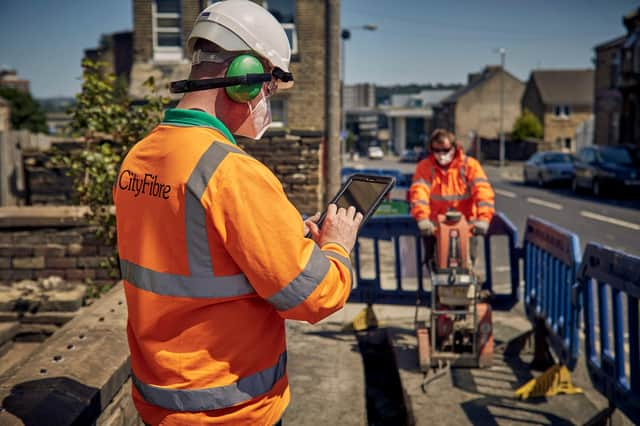Gigabit city plan to launch full fibre Scottish digital network


And it's expected that the move to remote working will continue, with a recent study by the Centre for Economic and Business Research (CEBR) revealing that 32 per cent of people are expecting to continue working from home at least some of the time.
It's therefore more important than ever that cities are digitally prepared for the 'new normal', and provision of full fibre connectivity is fast becoming the benchmark by which they will be judged.
CityFibre, the UK's third largest alternative provider of wholesale fibre network infrastructure, is at the forefront of this revolution, committed to delivering a “Gigabit Scotland” where almost every premise in its major cities can access full fibre and broadband speeds of up to 1000 Mbps on both the upload and the download.


Elaine Doherty, CityFibre's regional lead for Scotland and the north east of England, explains that full fibre is a piece of glass fibre that transmits data extremely fast in the form of light right into your home, however traditional telephone networks only use the fibre from the national network to a cabinet in your street, with a slower copper cable used the rest of the way to your home.
CityFibre realised that bridging this gap by providing full fibre for the entire network from source to destination – your home or business, would vastly increase the speed and reliability of any broadband service. In addition, unlike copper cables, full fibre is not shared with neighbours, so the highest broadband speed is guaranteed. It's also more reliable and better for the environment than traditional copper networks as it requires less power and power is only used on demand.
The need for major investment is acute: the UK is ranked 29th out of 30 Organisation for Economic Cooperation and Development (OECD) nations in terms of full fibre coverage, just behind Germany and ahead of the Czech Republic. At the top end of the scale is Japan, followed by South Korea and Spain.
CityFibre is working hard to improve this position and, working with consultancy Regeneris, it has calculated the minimum positive impact its investment will have over a 15-year period on the economy across 100 British towns and cities is £43billion; for Scotland the forecasted economic benefit is £5.2billion.


Doherty says: “In the UK CityFibre are building 69 fibre to the premises (FTTP) Gigabit Cities investing a massive £4 billion which will deliver full fibre to up to 8 million homes by 2025. In Scotland that equates to over £400million investment in cities and about a £5.2 billion return on investment over the next 15 years.”
The first stage to achieving a Gigabit City, is the installation of a public sector wide area network (WAN) connecting public buildings such as council offices, schools and health centres. Then as many houses as possible are connected to the network through Fibre to the Premises (FTTP). This extended network has the added advantage of allowing smart city solutions and 5G mobile services to be rolled out across the city.
In Scotland, full fibre networks are being built across the Glasgow City Region, Aberdeen, Edinburgh, Stirling, Inverness and Dundee. “Today it's about being able to work from home, access entertainment easily and seamlessly and connect devices to the network without any problems,” she says.
Securing higher bandwidth broadband at home is, however, only part of the story; the availability of full fibre down almost every street will also power our smart cities of the future.
Doherty says: “Full fibre underpins smart cities solutions which use the latest technology to capture real time data on the world around us and combine it with artificial intelligence to deliver information which can be used by individuals to make better informed decisions on, for example, being able to make an informed decision on which mode of transport they wish to use to get where they want to be by the most effective, carbon efficient way. Traffic management can be improved by sharing data collected by CCTV and traffic signals to reroute traffic and emergency vehicles automatically, and businesses can better plan deliveries to minimise hold ups.
Education at all levels can also benefit from full fibre, with the need for investment in technology highlighted when schools closed during the pandemic and learning became remote. Educational establishments can also benefit from full fibre to enrich the learning experience with virtual reality and augmented reality applications in lessons.
Full fibre also has benefits for healthcare as Doherty explains: “Having fibre in your home can allow medical professionals to do much more than provide online consultations. Medical equipment can be centrally monitored and over time move from addressing specific acute issue to introducing preventative measures.”
“The availability of full fibre will be truly transformational for many aspects of our lives. By making remote working easier, the mental health of employees often improves through better work life balance, the local economy gains from people spending in their communities and businesses can reduce costly office space.
Doherty concludes: “Covid-19 has shone a light on digital inclusion and education, and the increasing demands on the network. Full fibre helps our nation and cities engage people, collaborate, and respond to everyday things. A truly national gigabit network allows the growing gig economy to come to life. Full fibre will help meet the needs of society and the workforce in future.”
To find out more and register your interest visit: www.cityfibre.com/gigabit-cities